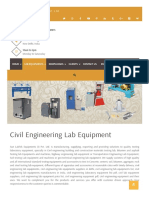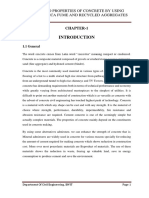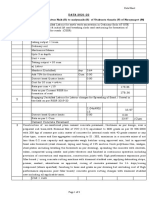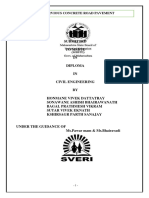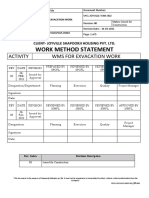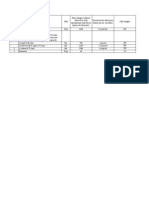Lab Report Sample Format
Uploaded by
Alexis RoguelLab Report Sample Format
Uploaded by
Alexis RoguelLaboratory Experiment No.
1
STANDARD PROCTOR TEST
LABORATORY EXPERIMENT NO. 1
STANDARD PROCTOR TEST
CE152L – GEOTECHNICAL ENGINEERING 2 (LAB)
CE152L – GEOTECHNICAL ENGINEERING 2 (LABORATORY)
1
Laboratory Experiment No. 1
STANDARD PROCTOR TEST
INTRODUCTION
Two types of compaction tests are routinely performed: (1) The Standard Proctor Test,
and (2) The Modified Proctor Test. Each of these tests can be performed in three different
methods as outlined in the attached Table 1. In the Standard Proctor Test, the soil is compacted
by a 5.5 lb hammer falling a distance of one foot into a soil filled mold. The mold is filled with
three equal layers of soil, and each layer is subjected to 25 drops of the hammer. The Modified
Proctor Test is identical to the Standard Proctor Test except it employs, a 10 lb hammer falling a
distance of 18 inches, and uses five equal layers of soil instead of three. There are two types of
compaction molds used for testing. The smaller type is 4 inches in diameter and has a volume of
about 1/30 ft3 (944 cm3), and the larger type is 6 inches in diameter and has a volume of about
1/13.333 ft3 (2123 cm3). If the larger mold is used each soil layer must receive 56 blows instead
of 25 (See Table 1).
OBJECTIVES
1. To perform a laboratory compaction test using the standard effort dynamic hammer and
standard compaction mold.
2. To measure the variation of compacted dry density as a function of water content.
STANDARD REFERENCE
CE152L – GEOTECHNICAL ENGINEERING 2 (LABORATORY)
2
Laboratory Experiment No. 1
STANDARD PROCTOR TEST
ASTM D 698 – Standard Test Methods for Laboratory Compaction Characteristics of Soil Using
Standard Effort (12,400 ft-lbs/ft3 (600 KN-m/m3))
SIGNIFICANCE AND USE
Mechanical compaction is one of the most common and cost effective means of
stabilizing soils. An extremely important task of geotechnical engineers is the performance and
analysis of field control tests to assure that compacted fills are meeting the prescribed design
specifications. Design specifications usually state the required density (as a percentage of the
“maximum” density measured in a standard laboratory test), and the water content. In general,
most engineering properties, such as the strength, stiffness, resistance to shrinkage, and
imperviousness of the soil, will improve by increasing the soil density.
The optimum water content is the water content that results in the greatest density for a
specified compactive effort. Compacting at water contents higher than (wet of ) the optimum
water content results in a relatively dispersed soil structure (parallel particle orientations) that is
weaker, more ductile, less pervious, softer, more susceptible to shrinking, and less susceptible to
swelling than soil compacted dry of optimum to the same density. The soil compacted lower than
(dry of) the optimum water content typically results in a flocculated soil structure (random
particle orientations) that has the opposite characteristics
of the soil compacted wet of the optimum water content
to the same density.
APPARATUS (See figure A)
Molds Trowel
Manual rammer #4 sieve
Extruder Moisture cans
Balance Graduated cylinder
Drying oven Straight Edge
Mixing pan
TEST SPECIMEN
Approximately 15 lbs of air-dried soil.
TEST PROCEDURE
1. Depending on the type of mold you are using obtain a sufficient quantity of air-dried soil in
large mixing pan. For the 4-inch mold take approximately 10 lbs, and for the 6-inch mold take
roughly 15 lbs. pulverize the soil and run it through the # 4 sieve.
2. Determine the weight of the soil sample as well as the weight of the compaction mold with its
base (without the collar) by using the balance and record the weights.
3. Compute the amount of initial water to add by the following method:
CE152L – GEOTECHNICAL ENGINEERING 2 (LABORATORY)
3
Laboratory Experiment No. 1
STANDARD PROCTOR TEST
(a) Assume water content for the first test to be 8 percent.
(b) Compute water to add from the following equation:
( soil mass∈ grams ) 8
water ¿ add ( ¿ ml ) =
100
Where “water to add” and the “soil mass” are in grams. Remember
that a gram of water is equal to approximately one milliliter of water.
4. Measure out the water, add it to the soil, and then mix it thoroughly
into the soil using the trowel until the soil gets a uniform color (See
Photos B and C).
5. Assemble the compaction mold to the base, place some soil in the
mold and compact the soil in the number of equal layers specified by the
type of compaction method employed (See Photos D and E). The
number of drops of the rammer per layer is also dependent upon the type
of mold used (See Table 1). The drops should be applied at a uniform
rate not exceeding around 1.5 seconds per drop, and the rammer should
provide uniform coverage of the specimen surface. Try to avoid rebound
of the rammer from the top of the guide sleeve.
6. The soil should completely fill the cylinder and the last compacted
layer must extend slightly above the collar joint. If the soil is below the
collar joint at the completion of the drops, the test point must be
repeated. (Note: For the last layer, watch carefully, and add more soil
after about 10 drops if it appears that the soil will be compacted below
the collar joint.)
7. Carefully remove the collar and trim off the compacted soil so that it
is completely even with the top of the mold using the trowel. Replace
small bits of soil that may fall out during the trimming process (See
Photo F).
8. Weigh the compacted soil while it’s in the mold and to the base, and
record the mass (See Photo G). Determine the wet mass of the soil by subtracting the weight of
the mold and base.
9. Remove the soil from the mold using a mechanical extruder (See
Photo H) and take soil moisture content samples from the top and bottom
of the specimen (See Photo I). Fill the moisture cans with soil and
determine the water content.
10. Place the soil specimen in the large tray and break up the soil until it
appears visually as if it will pass through the # 4 sieve, add 2 percent
CE152L – GEOTECHNICAL ENGINEERING 2 (LABORATORY)
4
Laboratory Experiment No. 1
STANDARD PROCTOR TEST
more water based on the original sample mass, and re-mix as in step 4. Repeat steps 5 through 9
until, based on wet mass, a peak value is reached followed by two slightly lesser compacted soil
masses.
ANALYSIS
1. Calculate the moisture content of each compacted soil specimen by
using the average of the two water contents.
2. Compute the wet density in grams per cm3 of the compacted soil
sample by dividing the wet mass by the volume of the mold used.
3. Compute the dry density using the wet density and the water content
determined in step 1. Use the following formula:
ρ
ρd =
1+ ω
where: w = moisture content in percent divided by 100
ρ = wet density in grams per cm3.
4. Plot the dry density values on the y-axis and the moisture contents on
the x-axis. Draw a smooth curve connecting the plotted points.
5. On the same graph draw a curve of complete saturation or “zero air
voids curve”. The values of dry density and corresponding moisture
contents for plotting the curve can be computed from the following
equation:
where:
ρd = dry density of soil grams per cm3
Gs = specific gravity of the soil being tested (assume 2.70 if not given)
ρw = density of water in grams per cm3 (approximately1 g/cm3)
wsat = moisture content in percent for complete saturation.
6. Identify and report the optimum moisture content and the maximum
dry density.
REPORT
CE152L – GEOTECHNICAL ENGINEERING 2 (LABORATORY)
5
Laboratory Experiment No. 1
STANDARD PROCTOR TEST
Use the following tables to report the data and results.
Include all necessary computations after each table.
TRIAL TRIAL TRIAL TRIAL TRIAL
1 2 3 4 5
MC = Mass of empty, clean can (grams)
MCMS = Mass of can and moist soil (grams)
MCDS = Mass of can and dry soil (grams)
MS = Mass of soil solids (grams)
MW = Mass of pore water (grams)
w = water content, w%
Computation:
Trial No. _
Mass of soil solids, MS
MS = MCDS – MC =
Mass of pore water, MW
MW = MCMS – MCDS =
Water content, w
Mw
w= ×100 %=¿
Ms
w = _____
TRIAL TRIAL TRIAL TRIAL TRIAL
1 2 3 4 5
w = Actual average water content, w%
Mass of compacted soil and mold (grams)
Mass of mold (grams)
CE152L – GEOTECHNICAL ENGINEERING 2 (LABORATORY)
6
Laboratory Experiment No. 1
STANDARD PROCTOR TEST
Wet mass of soil in mold
Volume of mold
Wet density, ρ , (g/cm3)
Dry density, ρd , (g/cm3)
Computation:
Trial No. _
Wet density,
Mt
ρ= =¿
V
ρ=¿ ¿
Dry density, ρd
ρw
ρd = =¿
1+ w
ρd =¿ ¿
Plot of Dry Density vs Water Content:
DISCUSSION
CO1 1. What is soil compaction?
CE152L – GEOTECHNICAL ENGINEERING 2 (LABORATORY)
7
Laboratory Experiment No. 1
STANDARD PROCTOR TEST
_________________________________________________________________
_________________________________________________________________
_________________________________________________________________
_________________________________________________________________
_________________________________________________________________
_________________________________________________________________
CO1 2. What are the characteristics of the soil which can affect the compaction? Discuss
each.
_________________________________________________________________
_________________________________________________________________
_________________________________________________________________
_________________________________________________________________
CO1 3. Explain the principle why the soil can be compacted.
_________________________________________________________________
_________________________________________________________________
_________________________________________________________________
_________________________________________________________________
CO1 4. What is the importance of determining the optimum water content? Explain
briefly.
_________________________________________________________________
_________________________________________________________________
_________________________________________________________________
_________________________________________________________________
CONCLUSION
_________________________________________________________________
____________________________________________________________________________
____________________________________________________________________________
____________________________________________________________________________
REFERENCES:
(Must be in APA format)
GROUP # _:
Group members: (Alphabetical order, Surname must be written first.)
CE152L – GEOTECHNICAL ENGINEERING 2 (LABORATORY)
8
You might also like
- Service Training: Bomag Asphalt Manager Tandem Roller100% (4)Service Training: Bomag Asphalt Manager Tandem Roller194 pages
- Laboratory Experiment No. 1 Standard Proctor Test: ' Ce152L - Geotechnical Engineering 2 (Lab)No ratings yetLaboratory Experiment No. 1 Standard Proctor Test: ' Ce152L - Geotechnical Engineering 2 (Lab)11 pages
- 2019.03.27 QA-QC B&CI Piles Hand Out 1 PDF - Dr. FawziNo ratings yet2019.03.27 QA-QC B&CI Piles Hand Out 1 PDF - Dr. Fawzi137 pages
- Estimating, Costing AND Valuation: by RangawalaNo ratings yetEstimating, Costing AND Valuation: by Rangawala4 pages
- Civil Engineering Notes for Site Execution and PlanningNo ratings yetCivil Engineering Notes for Site Execution and Planning91 pages
- Performance Floors For Warehouses and Distribution CentresNo ratings yetPerformance Floors For Warehouses and Distribution Centres16 pages
- Bill of Quantities (Boq) : Rough Excavation Banking/filing Excavated EarthNo ratings yetBill of Quantities (Boq) : Rough Excavation Banking/filing Excavated Earth20 pages
- BoQ of Construction of 11 Storied Service BuildingNo ratings yetBoQ of Construction of 11 Storied Service Building6 pages
- Specification and Tender Schedule For Various Types of Repair of ConcreteNo ratings yetSpecification and Tender Schedule For Various Types of Repair of Concrete58 pages
- Syllabus: MX ROAD Total Duration: 64hrs Theory:2hrs/DayNo ratings yetSyllabus: MX ROAD Total Duration: 64hrs Theory:2hrs/Day4 pages
- Material Particulars Unit Quantity Rate AmountNo ratings yetMaterial Particulars Unit Quantity Rate Amount4 pages
- Residential Building Submission Drawing (30'x40') DWGNo ratings yetResidential Building Submission Drawing (30'x40') DWG1 page
- Engineering Hydrology 5th Edition K Subramanya 2024 scribd download100% (3)Engineering Hydrology 5th Edition K Subramanya 2024 scribd download32 pages
- 02d-Standard & Specifications Continued PDFNo ratings yet02d-Standard & Specifications Continued PDF354 pages
- Unit Conversation: Feet Inch Inch Sut Inch Feet 12 Sut Inch 8 Feet Meter 3.28No ratings yetUnit Conversation: Feet Inch Inch Sut Inch Feet 12 Sut Inch 8 Feet Meter 3.2841 pages
- Laying of CC Road From Srinivas Naik (H) To Malyanaik (H) of Utakunta Thanda (V) of Narayanpet (M)No ratings yetLaying of CC Road From Srinivas Naik (H) To Malyanaik (H) of Utakunta Thanda (V) of Narayanpet (M)3 pages
- Summary Sheet: Session Number: Date: Subject Expert: 1 12.03.2007No ratings yetSummary Sheet: Session Number: Date: Subject Expert: 1 12.03.200732 pages
- BWDB 'S Item Description (Volume-I) Updated On 21-10-2014100% (4)BWDB 'S Item Description (Volume-I) Updated On 21-10-2014110 pages
- 2.final WMS For Exvacation (SPCL-JOYVILLE-WMS-001)No ratings yet2.final WMS For Exvacation (SPCL-JOYVILLE-WMS-001)5 pages
- Methods of Measurement of Building and Civil EngineeringNo ratings yetMethods of Measurement of Building and Civil Engineering10 pages
- Modified Proctor Test: The University of Toledo Soil Mechanics LaboratoryNo ratings yetModified Proctor Test: The University of Toledo Soil Mechanics Laboratory7 pages
- CE133-1 - LEC1 - Introduction To Earthquake EngineeringNo ratings yetCE133-1 - LEC1 - Introduction To Earthquake Engineering25 pages
- Select: Section 1 Example: Application For A Current Bank AccountNo ratings yetSelect: Section 1 Example: Application For A Current Bank Account2 pages
- Select: Section 1 Example: Application For A Current Bank AccountNo ratings yetSelect: Section 1 Example: Application For A Current Bank Account2 pages
- Lecture No.4 - Soil Stabilization and Compaction100% (1)Lecture No.4 - Soil Stabilization and Compaction10 pages
- CIVL 392 - Chapter 5 - Compacting and GradingNo ratings yetCIVL 392 - Chapter 5 - Compacting and Grading59 pages
- BSI British Standards: UK National Annex To Eurocode 7: Geotechnical Design - Part 2: Ground Investigation and TestingNo ratings yetBSI British Standards: UK National Annex To Eurocode 7: Geotechnical Design - Part 2: Ground Investigation and Testing16 pages
- Investigating The Effect of Nanomaterials On Resistance Parameters of Clay SoilNo ratings yetInvestigating The Effect of Nanomaterials On Resistance Parameters of Clay Soil6 pages
- Variation of Index Properties of A Soil Profile With Depth (Case Study: Adamawa State Polytechnic Yola)No ratings yetVariation of Index Properties of A Soil Profile With Depth (Case Study: Adamawa State Polytechnic Yola)73 pages
- What Is The Need For Densification of Granular Soils?No ratings yetWhat Is The Need For Densification of Granular Soils?9 pages
- Stabilization of Black Cotton Soil by 15No ratings yetStabilization of Black Cotton Soil by 156 pages
- B.Tech, Civil Engg, 5th Sem, 2018-19 BatchNo ratings yetB.Tech, Civil Engg, 5th Sem, 2018-19 Batch16 pages
- Menard Hamidi Varaksin2018 Chapter GroundImprovementOfTankFoundatNo ratings yetMenard Hamidi Varaksin2018 Chapter GroundImprovementOfTankFoundat16 pages
- BQS552 Assigntment1 Group4 Ap2244h SoilNo ratings yetBQS552 Assigntment1 Group4 Ap2244h Soil37 pages
- Practices For Unbound Aggregate Pavement Layers-2013No ratings yetPractices For Unbound Aggregate Pavement Layers-2013192 pages
- A Road Building Opportunity PURE - CRETE - Eng - 02252011No ratings yetA Road Building Opportunity PURE - CRETE - Eng - 0225201148 pages
- Service Training: Bomag Asphalt Manager Tandem RollerService Training: Bomag Asphalt Manager Tandem Roller
- Laboratory Experiment No. 1 Standard Proctor Test: ' Ce152L - Geotechnical Engineering 2 (Lab)Laboratory Experiment No. 1 Standard Proctor Test: ' Ce152L - Geotechnical Engineering 2 (Lab)
- 2019.03.27 QA-QC B&CI Piles Hand Out 1 PDF - Dr. Fawzi2019.03.27 QA-QC B&CI Piles Hand Out 1 PDF - Dr. Fawzi
- Civil Engineering Notes for Site Execution and PlanningCivil Engineering Notes for Site Execution and Planning
- Performance Floors For Warehouses and Distribution CentresPerformance Floors For Warehouses and Distribution Centres
- Bill of Quantities (Boq) : Rough Excavation Banking/filing Excavated EarthBill of Quantities (Boq) : Rough Excavation Banking/filing Excavated Earth
- BoQ of Construction of 11 Storied Service BuildingBoQ of Construction of 11 Storied Service Building
- Specification and Tender Schedule For Various Types of Repair of ConcreteSpecification and Tender Schedule For Various Types of Repair of Concrete
- Syllabus: MX ROAD Total Duration: 64hrs Theory:2hrs/DaySyllabus: MX ROAD Total Duration: 64hrs Theory:2hrs/Day
- Residential Building Submission Drawing (30'x40') DWGResidential Building Submission Drawing (30'x40') DWG
- Engineering Hydrology 5th Edition K Subramanya 2024 scribd downloadEngineering Hydrology 5th Edition K Subramanya 2024 scribd download
- Unit Conversation: Feet Inch Inch Sut Inch Feet 12 Sut Inch 8 Feet Meter 3.28Unit Conversation: Feet Inch Inch Sut Inch Feet 12 Sut Inch 8 Feet Meter 3.28
- Laying of CC Road From Srinivas Naik (H) To Malyanaik (H) of Utakunta Thanda (V) of Narayanpet (M)Laying of CC Road From Srinivas Naik (H) To Malyanaik (H) of Utakunta Thanda (V) of Narayanpet (M)
- Summary Sheet: Session Number: Date: Subject Expert: 1 12.03.2007Summary Sheet: Session Number: Date: Subject Expert: 1 12.03.2007
- BWDB 'S Item Description (Volume-I) Updated On 21-10-2014BWDB 'S Item Description (Volume-I) Updated On 21-10-2014
- 2.final WMS For Exvacation (SPCL-JOYVILLE-WMS-001)2.final WMS For Exvacation (SPCL-JOYVILLE-WMS-001)
- Methods of Measurement of Building and Civil EngineeringMethods of Measurement of Building and Civil Engineering
- Modified Proctor Test: The University of Toledo Soil Mechanics LaboratoryModified Proctor Test: The University of Toledo Soil Mechanics Laboratory
- CE133-1 - LEC1 - Introduction To Earthquake EngineeringCE133-1 - LEC1 - Introduction To Earthquake Engineering
- Select: Section 1 Example: Application For A Current Bank AccountSelect: Section 1 Example: Application For A Current Bank Account
- Select: Section 1 Example: Application For A Current Bank AccountSelect: Section 1 Example: Application For A Current Bank Account
- BSI British Standards: UK National Annex To Eurocode 7: Geotechnical Design - Part 2: Ground Investigation and TestingBSI British Standards: UK National Annex To Eurocode 7: Geotechnical Design - Part 2: Ground Investigation and Testing
- Investigating The Effect of Nanomaterials On Resistance Parameters of Clay SoilInvestigating The Effect of Nanomaterials On Resistance Parameters of Clay Soil
- Variation of Index Properties of A Soil Profile With Depth (Case Study: Adamawa State Polytechnic Yola)Variation of Index Properties of A Soil Profile With Depth (Case Study: Adamawa State Polytechnic Yola)
- What Is The Need For Densification of Granular Soils?What Is The Need For Densification of Granular Soils?
- Menard Hamidi Varaksin2018 Chapter GroundImprovementOfTankFoundatMenard Hamidi Varaksin2018 Chapter GroundImprovementOfTankFoundat
- Practices For Unbound Aggregate Pavement Layers-2013Practices For Unbound Aggregate Pavement Layers-2013
- A Road Building Opportunity PURE - CRETE - Eng - 02252011A Road Building Opportunity PURE - CRETE - Eng - 02252011




